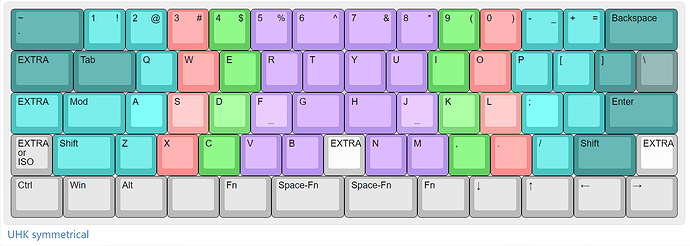The UHK has some strong points and a few unique ones. One of the advantages (and disadvantages at the same time) is the standard row stagger. That means the keyboard will be largely compatible to other keyboards, but has the drawbacks of a row staggered keyboard. Columnar stagger would resolve those drawbacks, but will be very different from a standard keyboard. I think a unique value proposition of a future UHK could be offering a layout close to a standard keyboard, but still getting rid of the row stagger problems. So in a perfect world UHK would offer three versions: row stagger, symmetrical stagger and columnar stagger.
A symmetrical stagger would allow to have almost a standard key arrangement, but just get rid of the row stagger. This would be highly beneficial as it makes switching between the UHK and standard keyboards more seamless. An ideal symmetrical stagger would consider ANSI and ISO layouts and would also allow to keep the number 6 on the left side or move it to the right side.
There is a website dedicated to symmetrical stagger. Their idea is like that.
I think that is the way to go in general, but I would fine-tune the number of keys and the stagger on the number row (likely to have no stagger on the number row, because that is closer to a standard keyboard and also natural to reach). Note that in the example the stagger is only 1/4 key width for the bottom row, which I think is better, then the default 1/2 key offset.
When there is interest to discuss that idea in more detail I will make a suggestion for a complete key arrangement and possibly also make a video demonstrating why that is potentially a great solution.
P.S.: I am aware of the X-Bows keyboard, which is a nice concept, but IMO gets it wrong in several places – mainly the too large distance between the fanned keys and some strange key sizes as well.




